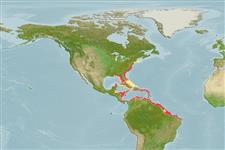Common names from other countries
>
Beloniformes (Needle fishes) >
Belonidae (Needlefishes)
Etymology: Strongylura: Greek, strongylos = round + Greek, oura = tail (Ref. 45335).
More on author: Walbaum.
Environment: milieu / climate zone / depth range / distribution range
Écologie
marin; eau douce; saumâtre récifal; profondeur 0 - ? m. Subtropical; 45°N - 9°S, 88°W - 34°W
Western Atlantic: Maine, USA and northern Gulf of Mexico to Brazil. Absent from the Bahamas and Antilles (Ref. 3129).
Taille / Poids / Âge
Maturity: Lm ? range ? - ? cm
Max length : 111 cm TL mâle / non sexé; (Ref. 40637); common length : 60.0 cm TL mâle / non sexé; (Ref. 5217); poids max. publié: 2.3 kg (Ref. 40637)
Rayons mous dorsaux (Total) : 14 - 17; Rayons mous anaux: 16 - 20. Black pigment behind eye, not extending below level of middle of eye (Ref. 26938).
Inhabits coastal areas and mangrove-lined lagoons. Enters freshwater. Feeds mainly on small fishes. Oviparous (Ref. 205). Eggs may be found attached to objects in the water by tendrils on the egg's surface (Ref. 205). Only the right gonad is developed (Ref. 26938). Marketed fresh.
Life cycle and mating behavior
Maturities | Reproduction | Spawnings | Egg(s) | Fecundities | Larves
Robins, C.R. and G.C. Ray, 1986. A field guide to Atlantic coast fishes of North America. Houghton Mifflin Company, Boston, U.S.A. 354 p. (Ref. 7251)
Statut dans la liste rouge de l'IUCN (Ref. 130435)
CITES (Ref. 128078)
Not Evaluated
Menace pour l'homme
Harmless
Utilisations par l'homme
Pêcheries: intérêt commercial mineur; pêche sportive: oui
Outils
Articles particuliers
Télécharger en XML
Sources Internet
Estimates based on models
Preferred temperature (Ref.
115969): 13.3 - 28, mean 26.1 (based on 304 cells).
Phylogenetic diversity index (Ref.
82804): PD
50 = 0.5001 [Uniqueness, from 0.5 = low to 2.0 = high].
Bayesian length-weight: a=0.00129 (0.00079 - 0.00211), b=3.05 (2.92 - 3.18), in cm Total Length, based on LWR estimates for this species & Genus-body shape (Ref.
93245).
Niveau trophique (Ref.
69278): 3.0 ±0.0 se; based on diet studies.
Résilience (Ref.
120179): Milieu, temps minimum de doublement de population : 1,4 à 4,4 années (Preliminary K or Fecundity.).
Fishing Vulnerability (Ref.
59153): High to very high vulnerability (67 of 100).
